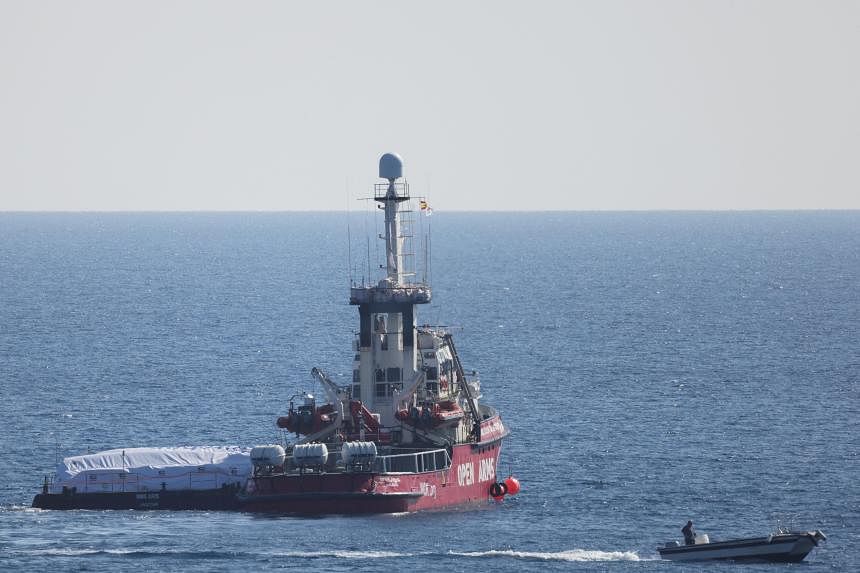LARNACA, Cyprus - A ship carrying 200 tonnes of food to Gaza left Cyprus on March 12 in a pilot project to open a new sea route for aid to a population that aid agencies say is on the brink of famine.
The charity ship Open Arms was seen sailing out of Larnaca port in Cyprus, towing a barge containing flour, rice and protein.
The mission was funded mostly by the United Arab Emirates and organised by US-based charity World Central Kitchen (WCK).
The journey to Gaza takes about 15 hours, but a heavy tow barge could make the trip considerably longer, possibly up to two days. Cyprus is just over 320km north-west of Gaza.
The United States military said its vessel, the General Frank S. Besson, was also en route to provide humanitarian relief to Gaza by sea.
With aid agencies saying deliveries into Gaza have been held up by bureaucratic obstacles and insecurity since the start of the war on Oct 7, and even Israel’s allies demanding easier aid access to the enclave, attention has shifted towards alternative routes, including by sea and air drops.
Qatar’s Foreign Ministry spokesman Majed Al-Ansari said on March 12 that negotiators seeking a ceasefire between Israel and Hamas, which controls Gaza, were not close to a deal.
Washington had said for weeks that it hoped for a truce deal in time for the Ramadan Muslim holy month that began this week, but this has so far failed to materialise, with the sides unable to agree on terms to halt fighting, free hostages and bring in aid.
The mission on March 12 was the culmination of months of preparation by Cyprus, the European Union member state closest to the scene of the hostilities.
Cyprus is keeping a wary eye on spillover effects from the upheaval in the Middle East and is already seeing migratory inflows from Lebanon increasing. More than 400 people arrived in fishing boats on March 11.
With the lack of port infrastructure, WCK has said it was creating a landing jetty in Gaza with material from destroyed buildings and rubble. This is an initiative separate from a plan announced by US President Joe Biden on March 7 to build a temporary pier in Gaza to facilitate aid deliveries by sea.
Construction of the jetty was “well under way”, WCK founder Jose Andres said in a post on X. “We may fail, but the biggest failure will be not trying!” he wrote, posting a picture of work with bulldozers apparently levelling out ground close to the sea.
The United Nations humanitarian office welcomed efforts to provide aid by sea and air, but warned they would not be enough. Aid agencies say such efforts can provide only limited relief as long as most land crossings are completely sealed off by Israel.
“It’s not a substitute for the overland transport of food and other emergency aid into Gaza,” said spokesperson Jens Laerke. “It cannot make up for that.”
Israel says it is not to blame for Gaza’s hunger, as it is allowing aid through two crossings at the southern edge of the territory. Aid agencies say that is not enough to get sufficient supplies through, much less distribute them safely in an increasingly lawless war zone.
‘Dire’ conditions
The UN estimates a quarter of the population in Gaza are at risk of starvation, particularly in Gaza’s north, which it says Israel has effectively put beyond reach of all supplies.
“The conditions on the ground and among the displaced are very dire. I have been touring the market since the morning and the prices are beyond the average people’s ability to afford,” said Mr Yamen, a father of four, whose family took shelter in Deir Al-Balah in the central Gaza Strip.
“We are being starved in two ways – food is scarce, and the little that is available is so expensive as to be beyond imagination.”
The war in Gaza has displaced most of the territory’s 2.3 million people, with more than half now crammed into the southern city of Rafah, mainly in makeshift tents.
There have been chaotic scenes and deadly incidents during aid distributions as desperately hungry people scrambled for food.
On March 12, Palestinian health officials reported that nine Palestinians were killed and dozens wounded by Israeli gunfire as crowds were awaiting aid trucks at the Kuwait Square in Gaza City.
In an incident in February, more than 100 Palestinians were killed while queueing for aid. The Gaza health authorities said Israeli fire was responsible; Israel denied blame and said the victims had been trampled.
“Bombing gatherings of hungry people has become a daily routine practised by the occupation and seen by the international community on screens,” Mr Ashraf Al-Qidra, spokesman for the Gaza Health Ministry, said on March 12.

“Hunger will claim the lives of all residents in northern Gaza. Aid is very scarce. The price of a meal could mean certain death. Help the people of the north. Don’t leave them prey to hunger, bombing and disease.”
Fighters from Hamas killed 1,200 people in an Oct 7 attack on Israel and took 253 hostages, according to Israeli tallies. Israel then launched a retaliatory assault on the enclave that has since killed at least 31,000 people. Much of Gaza’s infrastructure has also been destroyed.
Negotiations for a ceasefire remain deadlocked in Cairo.
Israel says any ceasefire must be temporary and that its goal remains the destruction of Hamas. Hamas says it will release hostages only as part of a deal that ends the war.
Qatar, mediator alongside Egypt and the US, said on March 12 it was working to establish a permanent ceasefire and not a short-term truce.
“We are not near to a Gaza ceasefire deal but remain hopeful,” the Qatari Foreign Ministry’s Mr Al-Ansari said at a press conference in Doha. REUTERS

